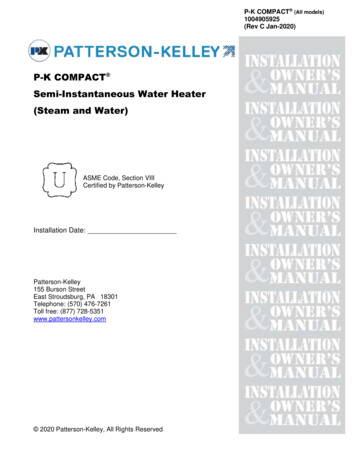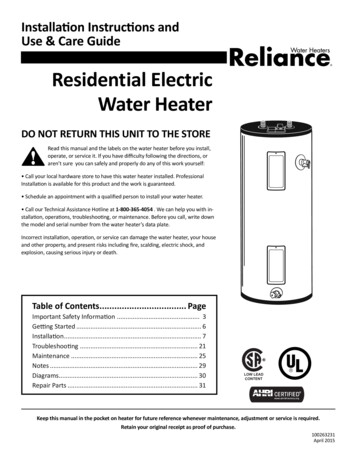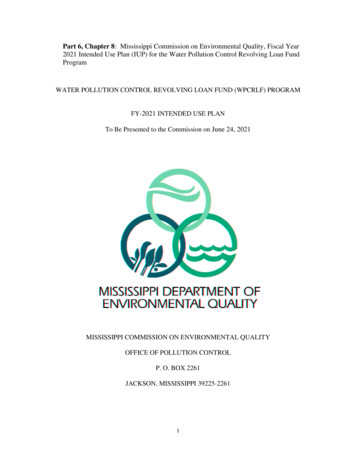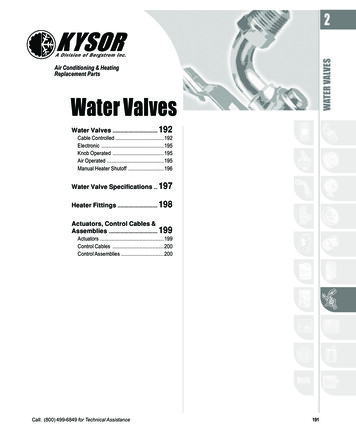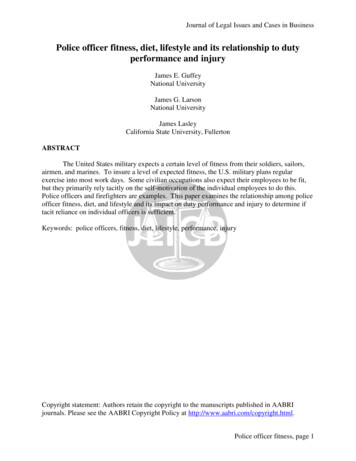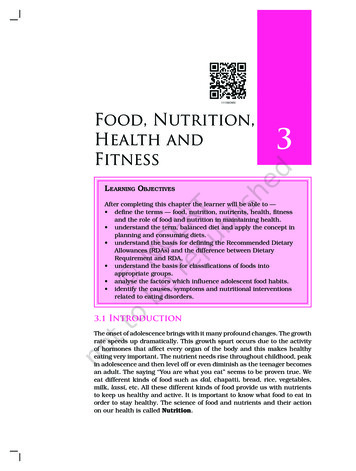
Transcription
Chapter 31Water and the Fitness ofthe EnvironmentPowerPoint Lecture Presentations forBiologyEighth EditionNeil Campbell and Jane ReeceLectures by Chris Romero, updated by Erin Barley with contributions from Joan SharpCopyright 2008 Pearson Education, Inc., publishing as Pearson Benjamin Cummings
Overview: The Molecule That Supports All of Life Water is the biological medium on Earth All living organisms require water more thanany other substance Most cells are surrounded by water, and cellsthemselves are about 70–95%water The abundance of water is the main reason theEarth is habitableCopyright 2008 Pearson Education, Inc., publishing as Pearson Benjamin Cummings2
The polarity of water molecules results inhydrogen bonding The water molecule is a polar molecule:The opposite ends have opposite charges Polarity allows water molecules to formhydrogen bonds with each otherAnimation: Water StructureCopyright 2008 Pearson Education, Inc., publishing as Pearson Benjamin Cummings3
Fig. 3-24Hydrogen bondsbetween watermolecules –Hydrogenbond H O –H – –
Four emergent properties of water contribute toEarth’s fitness for life Four of water’s properties that facilitate anenvironment for life are:– Cohesive behavior– Ability to moderate temperature– Expansion upon freezing– Versatility as a solventCopyright 2008 Pearson Education, Inc., publishing as Pearson Benjamin Cummings5
6Cohesion Collectively, hydrogen bonds hold watermolecules together, a phenomenon calledcohesion Cohesion helps the transport of water againstgravity in plants Adhesion is an attraction betweendifferent substances, for example, betweenwater and plant cell wallsAnimation: Water TransportCopyright 2008 Pearson Education, Inc., publishing as Pearson Benjamin Cummings
Fig. 3-37AdhesionWater-conductingcellsDirectionof watermovementCohesion150 µm
Surface tension is a measure of how hard it isto break the surface of a liquid Surface tension is related to cohesionCopyright 2008 Pearson Education, Inc., publishing as Pearson Benjamin Cummings8
Moderation of Temperature Water absorbs heat from warmer air andreleases stored heat to cooler air Water can absorb or release a largeamount of heat with only a slightchange in its own temperature, becauseof it's high specific heatCopyright 2008 Pearson Education, Inc., publishing as Pearson Benjamin Cummings9
Heat and Temperature Kinetic energy is the energy of motion Heat is a measure of the total amount ofkinetic energy due to molecular motion Temperature measures the intensity of heatdue to the average kinetic energy of moleculesCopyright 2008 Pearson Education, Inc., publishing as Pearson Benjamin Cummings10
11 The Celsius scale is a measure oftemperature using Celsius degrees ( C) A calorie (cal) is the amount of heat requiredto raise the temperature of 1g of water by1 C The joule (J) is another unit of energy where1 J 0.239 cal, or 1 cal 4.184 JCopyright 2008 Pearson Education, Inc., publishing as Pearson Benjamin Cummings
Water’s High Specific Heat12 The specific heat of a substance is theamount of heat that mustbeabsorbed or lost for 1 g of thatsubstance to change its temperature by 1ºC The specific heat of water is 1 cal/g/ºC Water resists changing its temperaturebecause of its high specific rmo/spht.htmlCopyright 2008 Pearson Education, Inc., publishing as Pearson Benjamin Cummings
13 Q mcΔT Q is the amount of heat needed to change thetemperature of a substance m is the mass of the heated substance c is the specific heat capacity ΔT (pronounced delta T) is the temperaturedifference; the difference in temperature beforeand after you applied the heat
14 Q m c T Now what does that mean? Suppose we want to know HOW MUCH HEAT is needed to change the temperature of asubstance this is the equation we use. Q heat. The unit of heat will be either the SI unit of heat energy called JOULES or itmay be measured in Calories as well, the older unit of heat. M Mass. The amount of heat needed to change the temperature of a certain amount ofa substance depends in part on HOW MUCH of the substance you have. Obviously youmust do much more work to change the temperature of a ton of iron than it will take tochange the temperature of 1 ounce of iron. “c” is called the “specific heat” of a substance. It turns out that every substance has acharacteristic specific heat. We can identify an unknown substance IF we know itsspecific heat. So when I wish to find out how much heat is needed to change thetemperature of a substance it helps to know the mass and the identity of the substance. The third piece of info needed is the amount of temperature change ( T). So it will take more energy, more work, more heat to change the temperature by 50degrees than to change the temperature by only 10 degrees. Q mc T If I know the mass and the identity of the substance and the amount by whichwe wish to change the temperature of a substance then we can calculate the amount ofwork, energy, heat needed to make the change.For Your Information
15 Water’s high specific heat can be traced tohydrogen bonding– Heat is absorbed when hydrogen bonds break– Heat is released when hydrogen bonds form The high specific heat of water minimizestemperature fluctuations to within limitsthat permit lifeCopyright 2008 Pearson Education, Inc., publishing as Pearson Benjamin Cummings
16The effect of a large body of water on climateLos Angeles(Airport) 75 70s ( F)80sSan Bernardino100 Riverside 96 Santa AnaPalm Springs84 106 Burbank90 Santa Barbara 73 Pacific Ocean90s100sSan Diego 72 40 miles
Evaporative Cooling Evaporation is transformation of a substancefrom liquid to gas Heat of vaporization is the heat a liquid mustabsorb for 1 g to be converted to gas As a liquid evaporates, its remaining surfacecools, a process called evaporative cooling Evaporative cooling of water helps stabilizetemperatures in organisms and bodies of waterCopyright 2008 Pearson Education, Inc., publishing as Pearson Benjamin Cummings17
18
HyperKewl Evaporative Cooling Vest, Khaki, Small19View LargerHyperKewl Evaporative Cooling Vest, Khaki,Small CloseLightweight, Durable and WashableSoak for just two or three minutes for five to 10hours of cooling relief! V-neck Vest has a zipperclosure. Comfortable, quilted nylon outer withHyperKewl polymer-embedded fabric inner andwater-repellent nylon liner. Just soak for twominutes and you're ready to go! ANSI complaintwith 3M reflective tape to keep you safe. Threelarge front pockets to stash yourgear.Compliance: ANSI 107-2004 Class II.Please Specify Men's Size: S, M, L, XL, XXL,3XL.
Fig. 3-6Ice floats in liquid water because hydrogen bonds in ice aremore “ordered,” making ice less denseIf ice sank, all bodies of water would eventually freezesolid, making life impossible on EarthHydrogenbondIceHydrogen bonds are stableWater reaches its greatest20Liquid waterHydrogen bonds break and re-formdensity at 4 C
The Solvent of Life A solution is a liquid that is a homogeneousmixture of substances A solvent is the dissolving agent of a solution The solute is the substance that is dissolved An aqueous solution is one in which water isthe solventCopyright 2008 Pearson Education, Inc., publishing as Pearson Benjamin Cummings21
Fig. 3-7– –– –– – Cl– Cl– Na –Na –– ––Water is aversatile solventdue to itspolarity, whichallows it to formhydrogen bondseasily22When an ionic compound isdissolved in water, each ion issurrounded by a sphere ofwater molecules called ahydration shell
23http://qwickstep.com/search/salt-dissolving.html
24
25 Water can also dissolve compounds made ofnonionic polar molecules Even large polar molecules such as proteinscan dissolve in water if they have ionic andpolar regionsCopyright 2008 Pearson Education, Inc., publishing as Pearson Benjamin Cummings
Hydrophilic and Hydrophobic Substances A hydrophilic substance is one that has anaffinity for water A hydrophobic substance is one that does nothave an affinity for water Oil molecules are hydrophobic because theyhave relatively nonpolar bonds A colloid is a stable suspension of fineparticlesCopyright 2008 Pearson Education, Inc., publishing as Pearson Benjamin Cummings26
Solute Concentration in Aqueous Solutions Most biochemical reactions occur in water Chemical reactions depend on collisions ofmolecules and therefore ontheconcentration of solutes in anaqueous solutionCopyright 2008 Pearson Education, Inc., publishing as Pearson Benjamin Cummings27
28 Molecular mass is the sum of all masses of allatoms in a molecule Numbers of molecules are usually measured inmoles, where 1 mole (mol) 6.02 x 1023molecules (Avogadro's number) Molarity (M) is the number of moles ofsolute per liter of solutionCopyright 2008 Pearson Education, Inc., publishing as Pearson Benjamin Cummings
29 Molarity (M) is the number of moles of soluteper liter of solutionEXAMPLE: The solution of C2H6O in 1 liter of water Molecular mass of one C2H6O molecule is: 12 2 24; 1 6 6; 16 1 16; 24 6 16 46 Therefore, if you dissolve 46 grams of C2H6Oin 1 liter of water, it would be 1M solution; if 92grams – 2M solution; if 4.6 grams – 0.1MsolutionCopyright 2008 Pearson Education, Inc., publishing as Pearson Benjamin Cummings
Concept 3.3: Acidic and basic conditions affectliving organisms A hydrogen atom in a hydrogen bond betweentwo water molecules can shift from one to theother:– The hydrogen atom leaves its electron behindand is transferred as a proton, or hydrogenion (H )– The molecule that lost the proton is now ahydroxide ion (OH–)Copyright 2008 Pearson Education, Inc., publishing as Pearson Benjamin Cummings30
Effects of Changes in pH Concentrations of H and OH– are equal in purewater Adding certain solutes, called acids and bases,modifies the concentrations of H and OH– Changes in concentrations of H and OH– candrastically affect the chemistry of a cell Biologists use something called the pH scale todescribe whether a solution is acidic or basic (theopposite of acidic)Copyright 2008 Pearson Education, Inc., publishing as Pearson Benjamin Cummings31
The pH Scale32An acid is anysubstance thatincreases the H concentration ofa solutionA base is anysubstancethat reducesthe H concentrationof a solutionCopyright 2008 Pearson Education, Inc., publishing as Pearson Benjamin Cummings
Fig. 3-91Battery acidGastric juice,2 lemon juiceH H – HH OH OH– H H H H Mostbiologicalfluids havepH values inthe range of6 to 833pH Scale03 Vinegar, beer,wine, colaAcidic solutionshave pH valuesless than 74 Tomato juiceAcidicsolution5Black coffeeRainwater6 UrineOH–H OH–H OH–OH– OH– HH H NeutralsolutionNeutral[H ] [OH–]Saliva7 Pure waterHuman blood, tears8 Seawater910OH–Milk of magnesiaOH–OH–H OH–––OH OHOH– HBasicsolution11Basic solutionshave pH valuesgreater than 7Household ammonia12Household13 bleachOven cleaner14
Buffers The internal pH of most living cells must remainclose to pH 7 Buffers are substances that minimize changes inconcentrations of H and OH– in a solutionA buffer solution has the property that the pH ofthe solution changes very little when a smallamount of strong acid or base is added to it. Buffersolutions are used as a means of keeping pH at anearly constant value in a wide variety of chemicalapplications. Many life forms thrive only in arelatively small pH range; an example of a buffersolution is blood - http://en.wikipedia.org/wiki/Buffer solutionCopyright 2008 Pearson Education, Inc., publishing as Pearson Benjamin Cummings34
Threats to Water Quality on Earth35 Acid precipitation refers to rain, snow, or fogwith a pH lower than 5.6 Acid precipitation is caused mainly by themixing of different pollutants (mainly SO2 ,NO2, CO2) with water in the air and can fall atsome distance from the source of pollutants Acid precipitation can damage life in aquaticenvironments (oceans, lakes, rivers) Effects of acid precipitation on soil chemistry arecontributing to the decline of some forestsCopyright 2008 Pearson Education, Inc., publishing as Pearson Benjamin Cummings
Fig. rainAcid precipitation and its effects on a forestMorebasic
37 Human activities such as burning fossil fuelsthreaten water quality CO2 is released by fossil fuel combustion andcontributes to:– A warming of earth called the“greenhouse” effect– Acidification of the oceans; this leads to adecrease in the ability of corals to form calcifiedreefsCopyright 2008 Pearson Education, Inc., publishing as Pearson Benjamin Cummings
38?
Liquid water Hydrogen bonds break and re-form Ice Hydrogen bonds are stable Ice floats in liquid water because hydrogen bonds in ice are more “ordered,” making ice less dense If ice sank, all bodies of water would eventually freeze solid, making life impossible on Earth Water reaches its greatest density at 4 C

